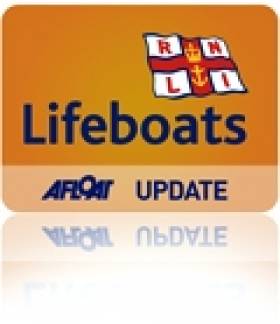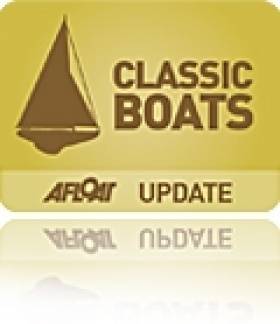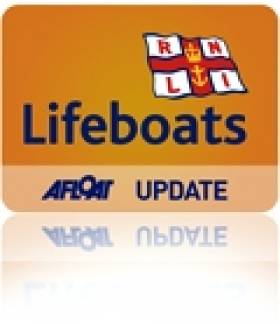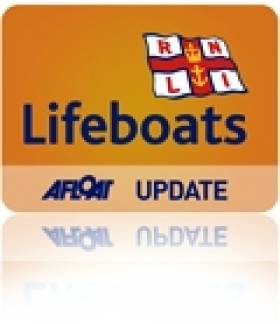Displaying items by tag: Bangor
Bangor Lifeboat Launched To Search For Missing Vessel
#RNLI - RNLI Bangor's lifeboat launched at 7.55pm last night (Saturday 14 March) to search for a missing 12ft RIB with two persons on board after the alarm was raised by Belfast Coastguard.
Within minutes of the rescue pagers being activated, volunteer crew had launched the lifeboat and located the missing boat close to the slipway at Ballyholme Bay.
The vessel had experienced engine failure and had been rowed closer to the shore by the owner.
Calm on-scene sea and weather conditions allowed for a tow line to be quickly rigged and passed to the stricken vessel. The boat was then towed to the safety of Bangor Harbour.
"Engine failure even close to shore could lead to a life threatening situation," said RNLI volunteer helmsman John Bell, who was involved in this rescue.
"We’re glad that the two people on board this boat are now safely ashore."
Bell went on to emphasise the RNLI’s five sea safety tips for anyone going afloat this summer.
"Always wear a lifejacket, secondly check your engine and fuel, thirdly tell others where you are going, fourthly carry some means of calling for help and final always check the weather and tides."
Reprieve For Classic Yacht As Belfast Wooden Boat Gets New Home
#Following Friday's Afloat.ie story on the scrapping of a Clasic Irish yacht, owner Eanan O'Doherty has received 'lots of emails' about the Bangor S27 Sorona due for breaking up.
Among the offers of assistance are emails from the Secretary of Co Down Heritage committee plus two boat preservation activists in Northern Ireland.
O'Doherty says he is delighted the boat does not need to be scrapped as he feared and instead is now hopeful Sorona will go to a new owner in a matter of weeks.
The 1963–built Sorona is in a yard at Monsterboice near Drogheda and has to be removed.
O'Doherty might even recover some of his losses on her, but at the very least, he says, she will now be saved.
He also says that if any club or group take her he will insist she when restored be used for sail training.
Who Will Save Classic Belfast Lough Yacht 'Sorona' From The Scrap Heap?
#yachttobescrapped – Round–the–world–yachtsman and Asgard restorer Pat Murphy has alerted classic boat fans to the fate of an Irish built Bangor S class 27' footer set to be scrapped next week. See more photos in the gallery below.
The 1963–built Sorona is in a yard at Monsterboice near Drogheda and has to be removed. According to Murphy and Dundalk classic boat colleague Charlie McCarthy, the owner is 'willing to let her go for the taking'.
The 27-foot S-Class boats are modest classics of their time representing a blend of styles and types. They were designed by Robert Slater in 1945, and all 22 of them were built at his boatyard the Shipyard Company in Bangor, Northern Ireland. (Sorona, the twentieth boat, was actually started by Robert Slater but completed by Bruce Cowley who bought the Shipyard Company from Robert Slater in the early 1960s, Bruce Cowley building the final two boats, Shejenka and Quinsibar, with their raised cabins). They manage to combine a little of the gentleman's yacht, a lot of the everyday cruiser built for an era of austerity, and just a touch of the tough working boat. More on the class history here.
Bought as a restoration project about seven years ago Sorona, the 20th boat of its type to be built, was partly stripped and covered untill last summer. 'It is very sad to see a basically sound boat about to be smashed up' says McCarthy.
For more informaton on Sorona contact [email protected]
Bangor Lifeboat Rescues Two On Stricken Trimaran In Belfast Lough
#RNLI - At 5.25pm yesterday evening (Tuesday 30 September) the Bangor RNLI volunteer lifeboat crew received a request from Belfast Coastguard to assist two people onboard a 28ft trimaran-type yacht.
The multihull vessel, consisting of a main hull and two out-rigging hulls, had experienced engine failure two nautical miles north of Black Head on northern shores of Belfast Lough.
Within minutes of the rescue pagers being activated, the volunteer crew had launched the lifeboat, which proceeded at full speed towards the stricken vessel.
Upon arrival, the crew found that the two people on board the yacht were experienced yachtsmen. They had followed procedure and made the correct decision to call for assistance at the first sign of trouble.
With weather conditions on scene deteriorating, and a moderate to rough sea state, one of the lifeboat crew was transferred to the yacht to assist in rigging a tow line.
The vessel was then taken under tow and after two-and-a-half hours arrived safely at Bangor Marina.
RNLI volunteer helmsman Connor Lawson used this rescue to highlight a RNLI safety message when he said: "We always urge everyone going afloat to make sure their engine and fuel systems and are well maintained and in good working order.
"Engine failure close to shore and commercial shipping routes could lead to a life threatening situation."
He added: "We're happy that everyone is now safely ashore."
Bangor Lifeboat Saves Children From Inflatable Raft
#RNLI - Bangor RNLI launched on Wednesday evening (30 July) to rescue five children who were being swept out to sea on an inflatable raft.
Belfast Coastguard requested the Bangor lifeboat to proceed at utmost speed to the shore at Whiteabbey, on the northern coastline of Belfast Lough.
Initial reports indicate that five children were aboard an inflatable raft and were being swept out to sea by the offshore winds.
At 7pm, within minutes of receiving the rescue alert, the volunteer crew had launched the lifeboat and were proceeding at full speed towards Whiteabbey.
The raft was quickly found with three children on board. Two others were found clinging to windsurfing boards alongside.
All five cold and exhausted children were rescued by the crew of RNLI Bangor lifeboat and were brought ashore at Carrickfergus Harbour into the safe care of waiting coastguards.
John Bell, volunteer RNLI helmsman who was involved in this rescue, said: "Inflatable boats and toys are great fun in the swimming pool but we do not recommend that people use them at the seaside because, as we've seen today, they can easily be blown out to sea.
"If you do find yourself in the situation where you or your child is being swept out to sea, stay in the boat shout for help and wave your arms. Do not attempt to swim for shore and if you're on the shore don't try and rescue them yourself – call 999 and ask for the coastguard."
#RNLI - Portaferry RNLI launched its inshore lifeboat yesterday afternoon (14 July) to the aid of a man who had suffered a head injury in one of the races during Portaferry Sailing Club’s annual regatta.
The lifeboat launched at 2.36pm and met up with the injured man a few minutes later on board his 12m yacht just off Marfield Bay in Strangford Lough, Co Down.
Weather conditions at the time were cloudy with good visibility, with a Force 2 to 3 southerly wind and calm seas.
After assessing the injured man’s condition, the volunteer crew transferred him into the lifeboat before taking him to Strangford Harbour, where he was then passed into the care of the Northern Ireland Ambulance Service.
Around the same time, RNLI Bangor was launching to investigate reports that children could have been on board an abandoned homemade raft spotted adrift off Ballymacormick Point on the edge of Belfast Lough.
Calm seas and fine weather allowed the lifeboat to proceed at full speed to the search area between Ballymacormick Point and Orlock Point.
After an extensive two-hour search of the area in conjunction with a fishing vessel and a coastguard rescue team, nothing was found.
The search was later terminated when enquiries found that there was a high probability that the raft had drifted from shore during high water.
Michael McKenna, volunteer RNLI helmsman who was involved in the search, took the opportunity to remind all children playing along the coast of the SAFE code: S for spot the dangers, A for always go with a friend, F for find and follow the safety signs and flags and E for Emergency - put up your hand and shout or ring 999/112 and ask for the coastguard.
It was the third callout for Bangor RNLI in three days, after a busy Saturday 12 July that began with a morning request from Belfast Coastguard to assist in the search for an inflatable dinghy.
The dinghy had been spotted by a concerned member of the public at the mouth of Larne Lough. The Bangor volunteer crew joined the Larne RNLI lifeboat in the search for the dinghy and its occupants. The former were quickly on scene and found the dinghy deserted with its engine down and a rope around the propeller.
The name painted on the dinghy hull was passed to Belfast Coastguard who were able to contact the owners. Thankfully, the owners reported that the dinghy had broken free from their vessel and that no one was on board.
The second call of the day came at 11:55am when the Bangor lifeboat launched to rescue four people from a motor boat that had broken down off the oil jetty at Cloghan Point, on the northern shores of Belfast Lough.
On scene, the RNLI crew quickly evaluated the situation and manoeuvred the lifeboat close to the broken-down vessel.
With relatively calm weather conditions, a tow rope was rigged and successfully passed to the motor boat, which was then towed the four miles back to the safety of Bangor Marina.
"Engine failure close to shore could lead to a life-threatening situation," said Bangor RNLI volunteer helmsman Iain Dobie.
"We always urge everyone going to sea to make sure their electrical systems and engine are well maintained and in good working order. A good anchor and chain should always be carried as part of essential safety equipment.
"We are glad the family on board this vessel are now safely ashore," he added.
#RNLI - A fishing vessel that developed steering trouble in Belfast Lough was towed to safety by Donaghadee RNLI’s all-weather lifeboat Saxon, assisted by Bangor RNLI’s inshore lifeboat.
The Donaghadee lifeboat launched at 3.20pm yesterday (Friday 9 May) after a request from Belfast Coastguard.
At the scene, six miles north-east of Orlock Point, a secure tow-line was established to the stricken trawler, which had a crew of six.
The vessel was towed to Bangor Harbour where the crew of Bangor’s Atlantic class lifeboat Jessie Hillyard assisted, safely guiding the trawler to a berth at the Eisenhower Pier. The Donaghdee lifeboat stood down at 5.40pm.
Donaghadee RNLI’s lifeboat operations manager Alan Couser said: “This rescue was a fine example of swift action and good teamwork by two lifeboat crews. Another potential tragedy has been averted.”
Elsewhere, a 75-foot fishing boat St Claire was finally towed to safety in Cork Harbour by the Courtmacsherry lifeboat last night after a marathon 11-hour operation.
As previously reported on Afloat.ie, the vessel had got into difficulties earlier in the day some 35 miles off the West Cork coast.
Poor sea conditions with strong winds resulted in a slowed return journey to shore.
Courtmacsherry RNLI deputy launching authority Dermot O'Mahony said: "All aboard the trawler were mighty pleased to be in safe harbour tonight.
"I would like to commend the volunteer lifeboat crew on their quick response for what has turned out to be a lengthy call-out."
The lifeboat crew on yesterday's call-out were coxswain Sean O 'arrell, mechanic Stewart Russell and crew Dara Gannon, Ken Cashman, Gary Barrett, Ciaran Hurley and Dave Philips.
Bangor Lifeboats Rescues Four From Stricken RIB
#RNLI - Bangor RNLI received a request from Belfast Coastguard yesterday evening (1 March) to launch their lifeboat and assist four people onboard a 23ft rigid inflatable boat, or RIB, that experienced engine failure north of Ballyholme Bay on the southern shores of Belfast Lough.
Within minutes of their rescue pagers being activated, the crew had assembled and had launched their inshore lifeboat, which proceeded at full speed towards the stricken vessel.
Upon arrival, the crew found that the four on board the RIB, who were experienced mariners, had followed procedure and made the correct decision to call for assistance at the first sign of trouble.
Calm on scene, weather conditions allowed for a tow line to be quickly rigged, and the vessel was then taken under tow to the safety of Bangor Marina.
Following the rescue, RNLI volunteer helmsman Iain Dobie took the opportunity to underline an important safety message.
"We always urge everyone going afloat to make sure their engine and fuel systems and are well maintained and in good working order," he said. "Engine failure close to shore and commercial shipping routes could lead to a life threatening situation."
Dobie added: "We're happy that everyone is now safely ashore."
#RNLI - RNLI Bangor's lifeboat launched at 4pm on Friday (12 July) to assist with the medical evacuation of an unconscious sailor from a 26ft yacht.
Within minutes of the rescue pagers being activated, volunteer crew had the lifeboat launched and quickly located the yacht in Ballyholme Bay, on the southern shores of Belfast Lough.
Crews from other vessels in the vicinity also quickly responded to the Mayday call; they had been able to come alongside the yacht and had administered first aid to the injured sailor. Once medically stabilised, the sailor was taken onboard the Bangor lifeboat.
Fine weather conditions allowed the lifeboat to proceed at full speed back to Bangor, were the injured sailor was transferred into the care of waiting paramedics.
Dr Iain Dobie, a volunteer crewman with RNLI Bangor, praised the actions of all crews involved.
"When the call for help went out we are pleased that crews from other vessels close by had quickly responded and provided vital medical assistance. They did a fantastic job, by the time we arrived the gentleman was conscious."
He added: "We all wish him a full and speedy recovery."
RNLI Crews Assist Windsurfer, Stricken Fishing Boat in Co Down
#RNLI - Portaferry RNLI rescued a windsurfer who got into difficulty off the Co Down coast yesterday (16 April).
The volunteer crew launched their inshore lifeboat before 5pm yesterday evening to go the aid of the injured windsurfer reported to be in the area of Pig Island, a small island in Strangford Lough close to Newtownards Sailing Club.
The weather at the time was described as blowing slight to moderate winds with good visibility.
The crew was on scene at 5.15pm where they found the man on Pig Island accompanied by two other men. The windsurfer, who was suffering from a shoulder injury, was transferred to the lifeboat and made comfortable before being taken to the sailing club, where he was then transferred into the care of the coastguard and passed to the ambulance service to be taken to hospital.
Speaking after the rescue, Portaferry RNLI lifeboat operations manager Brian Bailie said: "As the charity that saves lives at sea, we will always respond to any call for help where someone is in danger.
"Strangford Lough is a popular destination for a wide range of water sport enthusiasts and it is important that they take all necessary precautions when using the lough.
"As we are all aware, accidents can and do happen and it is at such times that the work carried out by the volunteer crews of the RNLI is so important."
Elsewhere in Co Down yesterday, Bangor and Donaghadee RNLI assisted a fisherman whose 28ft commercial fishing boat experienced engine failure.
The crew quickly located the disabled boat one mile west of the Copeland Islands at the mouth of Belfast Lough yesterday morning after 11.15am.
With the vessel drifting closer to the island shores and the wind gusting gale force eight, a tow line was quickly rigged and passed to the fishing boat. Bangor RNLI was escorted by Donaghadee RNLI's all-weather lifeboat as it towed the fishing vessel to the safety of Bangor Harbour.
Bangor RNLI volunteer helm Peter Scott, who was involved in this rescue, said: "Engine failure close to shore could lead to a life threatening situation. We always urge everyone going to sea to make sure their electrical systems and engine are well maintained and in good working order. A good anchor and chain should always be carried as part of essential safety equipment.
"We are glad the skipper of this vessel is now safely ashore," he added.







































































